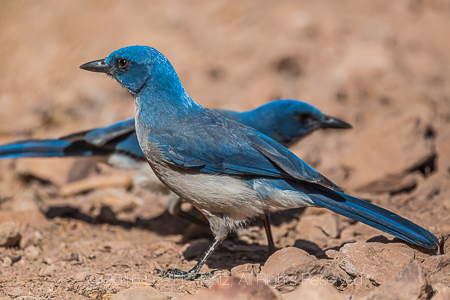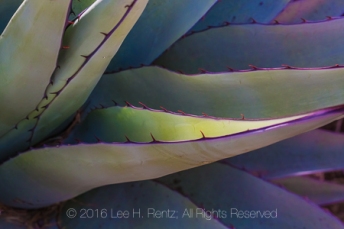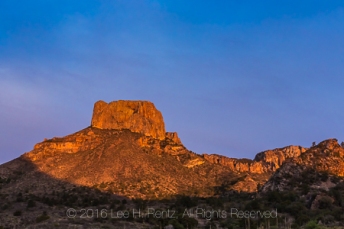Among birders, the legend lives on of the Colima Warbler, found among oak trees in a remote canyon high in the Chisos Mountains of Big Bend National Park. The species is mostly found in Mexico, but this region of south Texas has a couple of places where birders can fairly reliably stalk it, and we decided to be warbler stalkers for a day.
Early that May morning, we laced up our hiking boots and smeared on SPF 55, anticipating a long day in the bright sun. The route would take us from the Chisos Basin, where we were camped, to Boot Canyon, about 3.5 miles distant, with a 2,000 foot elevation gain.
As usual, my intention of finding the Colima Warbler got sidetracked almost immediately, when we walked past a dead Havard Century Plant that was cheeping at me. Huh? I looked on the other side of the brown flowering stalk and discovered a perfectly round hole that was clearly a nest with hungry baby birds in it. So, I hunkered down in the dust and waited for a parent to come. It didn’t take long until a wary mother Ladder-backed Woodpecker showed up and ducked quickly into the hole, where it fed the nestlings.

I was there a long time, and Karen had the opportunity to see a pair of Crissal Thrashers trying to thrash each other while waiting interminably for me to finish photographing. So she got a new species and I missed the opportunity entirely. Oh well, at least I got a few pictures of the woodpecker.
Next I got distracted by bugs, specifically some Giant Agave Bugs crawling around the tip of a rapidly growing Havard Century Plant stalk. Creepy? Yes. But I was amazed at the size of these creatures, which are in the scientific category known as “True Bugs.” Yes, that really is a category, though most real scientists would prefer to use the scientific name, Hemiptera, so that they don’t sound like 8-year-old boys with bug nets. These big bugs sip the sap of the century plant, though probably not enough to hurt it.

Onward and upward, we came upon our first Mexican Jays, which are loud and travel in gangs and aren’t very afraid of people. If Donald Trump was a birdwatcher, he would probably want to set up a wall, or at least a mist net, to stop these birds from entering the country. Though he might like their gaudy blue color and brash attitude. Seeing these jays was a first for us, as we climbed toward seeing 530 birds on our North American Life Lists.
Higher still, Karen spotted a Painted Redstart, in the oak and maple forest–another first for us and a stunningly beautiful bird. There were also Texas Madrone trees, similar to the Madrone trees of the west coast, but with minor differences that I apparently couldn’t see.
Over the pass with long views into Mexico. There were birdwatchers on their own journeys to see the famous Colima. There were also lots of backpackers heading up to campsites hidden all along the trails. It would be a beautiful place to backpack, except for the lack of water along the way, which means carrying the recommended one gallon of water (8+ lbs!) per person per day. That doesn’t leave a lot of room for camera equipment, but we all have our priorities. Would I rather photograph little birds or die of thirst in the desert? I’ll have to think about that one.

Meanwhile, we finally reached Boot Canyon, where the Colima Warbler had been spotted earlier in the week. We stood around. We listened. We walked a few feet. We scanned the canyon with our binoculars. And … nothing. I’m pretty sure I heard the warbler, but not sure enough to count it on my all-important life list. After an hour or so, we gave up on this location, hoping beyond hope that it had simply wandered down the trail we were taking. It didn’t.
We decided that since we had come this far, we might as well complete the 10+ mile loop, rather than going back the way we came. I busied myself with photographing century plants and cactus, since they can’t fly away and hide, although I am paranoid about poking myself in the eye with a sharp spine, which makes me cringe at the thought even as I write this.

- View down into desert from Boot Canyon Trail in the Chisos Mountains of Big Bend National Park
By the time we arrived back at the campground, our feet were aching and hot, and we were ready to rest. But that moment brought the best light of the day, with alpenglow or its desert equivalent lighting up Casa Grande with brilliant orange light. So I scurried around the campground trying to get the best angle on the iconic peak until I was bone tired.
We had “dipped” on the warbler: birdwatcher speak for not seeing a desirable bird that we had traveled miles to see, but it was still a great day.
Postscript: We arrived in El Paso late the next day, after passing through a fierce dust storm that sandblasted us with 60 mph winds and near zero visibility. With the temperature at 95 degrees F and the dust storm continuing, we wimped out and stayed in a motel rather than camping for the night. In the cool and quiet lobby of the motel, there was a birding tour group getting their final debriefing for their Texas trip by the trip leaders. It turned out that all these old birders (as in, anyone older than me!) had done the same hike we did, but with expert leadership, they had seen the Colima Warbler. I’ll be back and the punk warbler will make my day.
Gallery of hike photographs:
To see what the Colima Warbler is supposed to look like, go to Colima Warbler
For general information about visiting this stupendous national park, go to Big Bend National Park
Remember that Big Bend National Park is is the Chihuahuan Desert. If you go, make sure you plan your schedule to maximize your chance to see the warbler and other birds, and make sure to know the hazards of the desert ahead of time.
To see more of my work, read more of my blog entries here or go to my website Lee Rentz Photography.
















